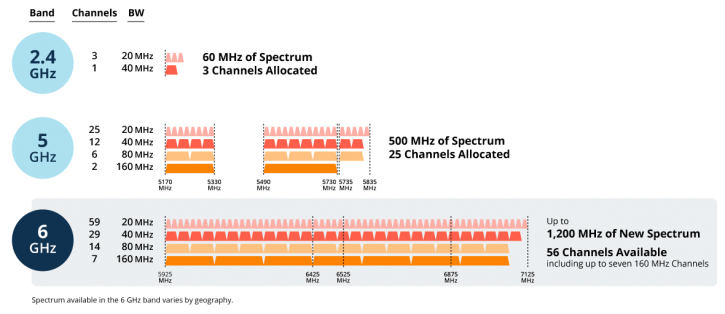Bits, Frames, and Packets
Access points
Why an access point? Here's the thing, in my house, we have weird LAN on all floors. However, now all devices require LAN. The move towards WiFi 6(E) and especially the 5/6 GHz band (AC/AX) in my home and workplace resulted in enhanced performance in terms of transfer speeds, as well as better handling of a large number of devices on the network. There is. However, one drawback is less range, especially when going through walls which can lead to wireless signal issues in a few areas in the house at the farthest points and, for some, the garage. Here's where an Access point comes into play. The AP has several mission-critical security features, such as intrusion detection and mediation technologies. As stated and apparent, it features WiFi 6, which can connect to many intelligent devices. It's also simple to set up and install because free cloud management software is available. These are only a few of the issues we'll have to consider.
Hardware EnGenius ECW336
The AP is powered by a quad-core 2.2GHz Qualcomm IPQ8072A (4x ARM Cortex A53) processor - yes, the EnGenius ECW336 is built on the Qualcomm Networking Pro 1210 platform. There is the Samsung SEC216 K4A8G16 1GB RAM, the Winbond W29N02GZBIBA 256MB NAND flash memory, the Marvell AQrate AQR114C GEN4 PHY for the 5GbE port, the Qualcomm PMP8074 power management FBGA, and the MT774 1CK G4 LED driver. A Qualcomm QCN5024 802.11ac WiFi chip is present. The Qualcomm QCN5054 802.11b/g/n/ax 22:2 chipset + 4x Qorvo 4226 front-end modules for the 2.4GHz band The EnGenius ECW336 is a tri-band access point, with 11a/b/g/n/ac/ax 44:4 chip + 4x Qorvo QPF4528 integrated front-end modules for the 5GHz band and the Qualcomm QCN9024 802.11ax chip with 4x CSHY front-end modules for the 6GHz band.
- 4×4:4 MU-MIMO WiFi 6 (802.11ax) compatible for top speeds on all bands
- 4 x 2.4 GHz: 5 dBi and 23 dBm transmit power
- 4 x 5 GHz: 6 dBi 23 dBm transmit power
- 4 x 6 GHz: 5 dBi 23 dBm transmit power
- 8.4 Gbps tri-radio aggregate frame rate for gigabit WiFi
- 5 GbE PoE+ port to maximize the connection speed and AP placement
- The 1200 MHz band that supports AR/VR, ultra-high HD, and other applications
- The 6 GHz interference-free band allows ultra-fast Gigabit WiFi speeds
- Integrated enterprise security and guest access
- Powerful built-in Qualcomm Quad-core CPU for superior performance and advanced 1024-QAM for faster packet transmission
- OFDMA and MU-MIMO for fast, efficient transmissions between the AP and client devices and BSS colouring for increased spatial reuse
- Access point diagnostic tools for real-time channel utilization
- Maximum Power Consumption: 22.5W
802.11ax = Wi-Fi 6
The 802.11ax standard is a big thing for Wi-Fi. The .ax name is changing though as the Wi-Fi Alliance will get renamed to Wi-Fi 6. They advance on that as 802.11ac and 802.11n was named Wi-Fi 5 and 4. The new name is introduced to make WIFI standards more easily recognizable. Let's face it, not everybody knows what 802.11ac means when I say it. Numbers are easy, and higher is better they must have thought.
Wi-Fi 6E refers to devices that operate in the 6-gigahertz (GHz) band, a new spectrum band. Our Wi-Fi has previously operated on two bands: 2.4 GHz and 5 GHz. The Wi-Fi 6 standard includes several features that improve the efficiency and data throughput of your wireless network while also lowering latency in those two bands. Wi-Fi 6E extends these enhancements to the 6-GHz band.
Wi-Fi 6E extends Wi-Fi 6's capacity, efficiency, coverage, and performance into the 6-GHz band. "Wi-Fi 6E devices deliver greater network performance and support more Wi-Fi users at once, even in very dense and congested environments," says Kevin Robinson, senior vice president of marketing for the Wi-Fi Alliance.
Each band represents a frequency chunk. The 2.4-GHz band is divided into 11 channels, each 20 megahertz (MHz) wide. The 5-GHz band has 45 channels, but they can be fused to form 40-MHz or 80-MHz channels, allowing them to transmit more data at the same time. The 6-GHz band supports 60 channels with a bandwidth of up to 160 MHz. That is a lot of extra bandwidth. Consider the transition from a single-track road (2.4 GHz) to a three-lane highway (5 GHz) to a six-lane superhighway (6 GHz). The analogy also applies to coverage. Because higher frequencies have a more difficult time penetrating solid walls and floors, single-track 2.4-GHz roads travel further than 5-GHz highways, which travel further than 6-GHz superhighways.
- Wi-Fi 6 to identify devices that support 802.11ax technology
- Wi-Fi 5 to identify devices that support 802.11ac technology
- Wi-Fi 4 to identify devices that support 802.11n technology
With whole-home gigabit coverage and multi-gigabit Wi-Fi capability, ordinary households may now enjoy next-generation computing experiences formerly reserved for vendor demos or trade exhibitions. Consider playing virtual reality games everywhere in your house or giving augmented reality business presentations, all while other family members are streaming Netflix or neighbours are watching YouTube. With any new technology that appears too fantastic to be true, there is generally a hidden "thing." If Wi-Fi 6E has a weakness, it is that the 6GHz wireless band employs shorter wavelengths.
Short wavelengths are ideal for quick data transfers. Still, they struggle to travel long distances and are more susceptible to interference from physical obstacles such as dense walls or floors in a building. Any real-world Wi-Fi 6E network will almost certainly use the 6GHz and 5GHz bands to provide fast, dependable connections throughout a house or business building. It is also possible that future Wi-Fi 6E networks will combine a core Wi-Fi 6E router with one or more Wi-Fi 6E repeaters to construct a wireless mesh network that offers the promised Wi-Fi 6E performance even in big residences or office buildings with multiple obstructions.
But yeah, let's have a peek, shall we?


